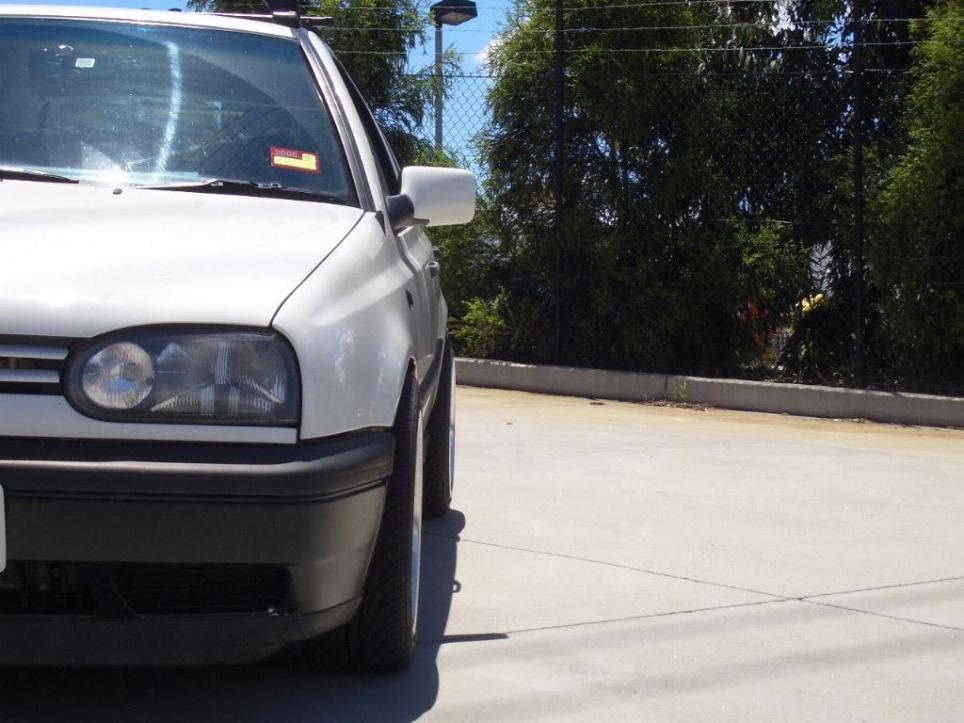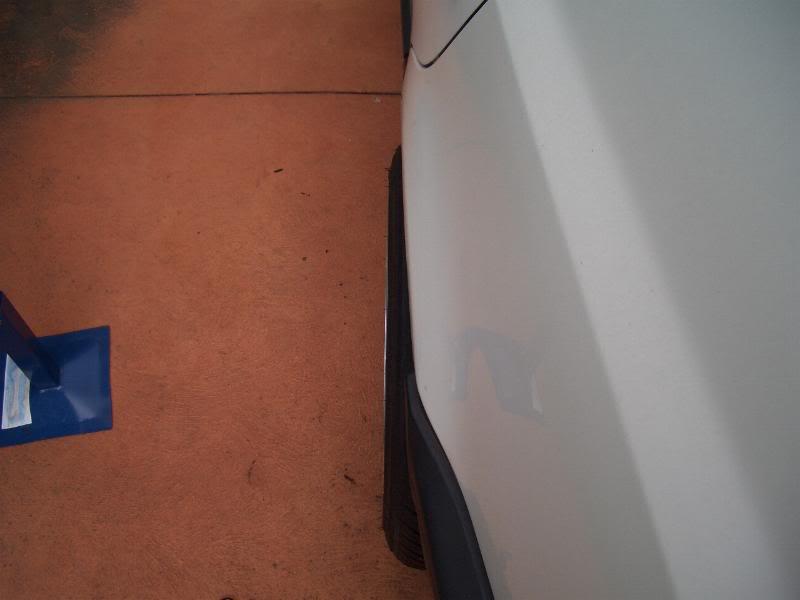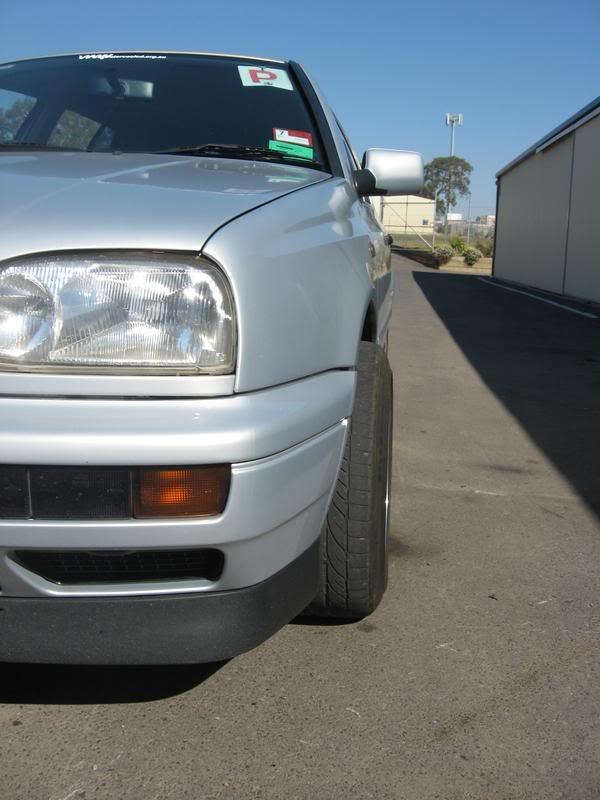Tazzy, this is a difficult situation when it comes to getting the right offset.
First off, a lesson on wheel width and offset (can be intense, so don't read this on a bad day!).
<BEGIN LESSON>

Offset is measured in millimetres from the CENTRE AXIS of the wheel to the MOUNTING SURFACE of the wheel. ET (google says it means "Einpresstiefe" which in German means "insertion depth") is often accompanied by the offset value so as to tell you that it's the offset value. If the mounting surface is located closer towards the outside edge of the wheel, the wheel is known to have a POSITIVE OFFSET. If the mounting surface is closer towards the inside edge of the wheel, the wheel is known to have a NEGATIVE OFFSET.
Now, because the offset measurement is based on the CENTRE AXIS of the wheel, the amount of backspacing and lip (or dish) the wheel has is all dependent on the offset. A particular wheel at a particular width with positive offset will have LESS DISH and a LARGER BACKSPACING than the same wheel if it had a negative offset. The higher offset wheel will sit further into the car than a lower offset wheel, providing more fender clearance, but reducing suspension clearance. The opposite applies.
Now, applying this to spacers - think of adding a spacer as extending the mounting surface of the wheel:

The red indicates the spacer. The blue line is the new offset after adding a spacer, and the green offset was the original offset without the spacer. In the case of the above diagram, you can see that the offset (which was previously a high positive offset) has now been reduced (to a lower positive offset). So like Neil's wheels and his calculations, the original offset of ET52 on his wheels have now been reduced to ET27 due to a 25mm spacer. If Neil was to use a 60mm spacer, the new offset will become ET-8. It may be hard to grasp at first but just remember that offset is measured from the CENTRE AXIS of the wheel.
One last piece to the puzzle. Offset is largely DEPENDENT on the width of the wheel. Right now, we know that, for example, a 6" wide wheel with ET38 will sit further into the car than a 6" wide wheel with ET8. But what about different widths? An 8" wide wheel with ET38 will sit very differently to a 6" wide wheel with ET38. If you think about (and because I've been repeating it ) offset is measured from the centre axis. Using the above example, because they have the same offsets, the extra width in the 8" is 'distributed' evenly to either side of the wheel, i.e. the extra two inch (50.8mm) is divided evenly to the lip and the backspacing. Compared to the 6" wheel, the 8" will have an additional 25.4mm lip, and an additional 25.4mm of backspacing.
) offset is measured from the centre axis. Using the above example, because they have the same offsets, the extra width in the 8" is 'distributed' evenly to either side of the wheel, i.e. the extra two inch (50.8mm) is divided evenly to the lip and the backspacing. Compared to the 6" wheel, the 8" will have an additional 25.4mm lip, and an additional 25.4mm of backspacing.
Now I think we can apply it to your car and the Volks CV wheels. Let's get the numbers down first - your stock VR6 wheels are 6.5" wide, ET43. The Volks are 7" wide, ET30; 8" wide, ET35. With the spacers you want to fit (I'm assuming 30mm each corner), this will push the Volks out to ET0 and ET5 respectively. I can tell you now that you will have LOTS of suspension clearance so no problems there. However, the 7" Volks, being 1/4" (~6.4mm) wider on each side of the wheel (totalling 1/2" wider) and having a reduced offset of 43mm compared to the stock VR6 wheels, will now sit 43 + 6.4 = 49mm further out. Assuming the 7" will go at the front (for looks), they will poke, A LOT. I had a similar setup before (7" wide with final offset of around the ET0 mark) on VR6 brakes and this is what it looked like:

Suffice to say the wheels didn't stay on after those pictures.
As for the 8" wide Volks, they will be 3/4" wider on each side of the wheel (total 1.5" wider) and a reduced offset by 38mm will mean it will have an extra lip of 38 + 19.1 = 57.1mm. For the rears, it's still pretty major poke and you might be able to escape with minor rubbing on thoroughly rolled fenders and stretched tyres (I'm thinking 195/45R16 or 195/40R16). To give you an idea:

That's 8" wide ET12 on the rears. With the 8" Volks at ET5, imagine an extra 7mm poke.
<END LESSON>
I'm wondering though, why use such a thick spacer? The VR6 brakes don't have that massive of a caliper to warrant a 30mm spacer on each corner? Volks largely produces racing wheels and I believe the CV is one as well, so they would have designed it with big calipers in mind. That said, if they don't clear the calipers, then I think you won't need a large spacer at all to get them to clear. I'm thinking max 10mm each corner really...
Anyway, using the figures I bolded, if you decide to use smaller spacers, just deduct the values and you should get a new "poke" measurement so you can compare with your stock VR6 wheels.
First off, a lesson on wheel width and offset (can be intense, so don't read this on a bad day!).
<BEGIN LESSON>

Offset is measured in millimetres from the CENTRE AXIS of the wheel to the MOUNTING SURFACE of the wheel. ET (google says it means "Einpresstiefe" which in German means "insertion depth") is often accompanied by the offset value so as to tell you that it's the offset value. If the mounting surface is located closer towards the outside edge of the wheel, the wheel is known to have a POSITIVE OFFSET. If the mounting surface is closer towards the inside edge of the wheel, the wheel is known to have a NEGATIVE OFFSET.
Now, because the offset measurement is based on the CENTRE AXIS of the wheel, the amount of backspacing and lip (or dish) the wheel has is all dependent on the offset. A particular wheel at a particular width with positive offset will have LESS DISH and a LARGER BACKSPACING than the same wheel if it had a negative offset. The higher offset wheel will sit further into the car than a lower offset wheel, providing more fender clearance, but reducing suspension clearance. The opposite applies.
Now, applying this to spacers - think of adding a spacer as extending the mounting surface of the wheel:

The red indicates the spacer. The blue line is the new offset after adding a spacer, and the green offset was the original offset without the spacer. In the case of the above diagram, you can see that the offset (which was previously a high positive offset) has now been reduced (to a lower positive offset). So like Neil's wheels and his calculations, the original offset of ET52 on his wheels have now been reduced to ET27 due to a 25mm spacer. If Neil was to use a 60mm spacer, the new offset will become ET-8. It may be hard to grasp at first but just remember that offset is measured from the CENTRE AXIS of the wheel.
One last piece to the puzzle. Offset is largely DEPENDENT on the width of the wheel. Right now, we know that, for example, a 6" wide wheel with ET38 will sit further into the car than a 6" wide wheel with ET8. But what about different widths? An 8" wide wheel with ET38 will sit very differently to a 6" wide wheel with ET38. If you think about (and because I've been repeating it
 ) offset is measured from the centre axis. Using the above example, because they have the same offsets, the extra width in the 8" is 'distributed' evenly to either side of the wheel, i.e. the extra two inch (50.8mm) is divided evenly to the lip and the backspacing. Compared to the 6" wheel, the 8" will have an additional 25.4mm lip, and an additional 25.4mm of backspacing.
) offset is measured from the centre axis. Using the above example, because they have the same offsets, the extra width in the 8" is 'distributed' evenly to either side of the wheel, i.e. the extra two inch (50.8mm) is divided evenly to the lip and the backspacing. Compared to the 6" wheel, the 8" will have an additional 25.4mm lip, and an additional 25.4mm of backspacing.Now I think we can apply it to your car and the Volks CV wheels. Let's get the numbers down first - your stock VR6 wheels are 6.5" wide, ET43. The Volks are 7" wide, ET30; 8" wide, ET35. With the spacers you want to fit (I'm assuming 30mm each corner), this will push the Volks out to ET0 and ET5 respectively. I can tell you now that you will have LOTS of suspension clearance so no problems there. However, the 7" Volks, being 1/4" (~6.4mm) wider on each side of the wheel (totalling 1/2" wider) and having a reduced offset of 43mm compared to the stock VR6 wheels, will now sit 43 + 6.4 = 49mm further out. Assuming the 7" will go at the front (for looks), they will poke, A LOT. I had a similar setup before (7" wide with final offset of around the ET0 mark) on VR6 brakes and this is what it looked like:

Suffice to say the wheels didn't stay on after those pictures.
As for the 8" wide Volks, they will be 3/4" wider on each side of the wheel (total 1.5" wider) and a reduced offset by 38mm will mean it will have an extra lip of 38 + 19.1 = 57.1mm. For the rears, it's still pretty major poke and you might be able to escape with minor rubbing on thoroughly rolled fenders and stretched tyres (I'm thinking 195/45R16 or 195/40R16). To give you an idea:

That's 8" wide ET12 on the rears. With the 8" Volks at ET5, imagine an extra 7mm poke.
<END LESSON>

I'm wondering though, why use such a thick spacer? The VR6 brakes don't have that massive of a caliper to warrant a 30mm spacer on each corner? Volks largely produces racing wheels and I believe the CV is one as well, so they would have designed it with big calipers in mind. That said, if they don't clear the calipers, then I think you won't need a large spacer at all to get them to clear. I'm thinking max 10mm each corner really...
Anyway, using the figures I bolded, if you decide to use smaller spacers, just deduct the values and you should get a new "poke" measurement so you can compare with your stock VR6 wheels.





 Maybe when I stop being lazy and fold my guard lips and get the tape measure out i'll do it
Maybe when I stop being lazy and fold my guard lips and get the tape measure out i'll do it 

 Not sure, are the laws the same for all states? Can mainlanders have a little poke?
Not sure, are the laws the same for all states? Can mainlanders have a little poke?
Comment